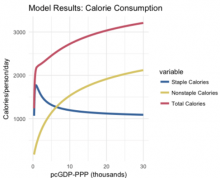The Edmonds model divides food consumption into two categories, staples, which represent basic foodstuffs, and nonstaples, which represent higher-quality foods. Demand for staples increases at low income, but eventually peaks and begins to decline with higher income. Demand for nonstaples increases with income over all income ranges; however, total (staple + nonstaple) demand saturates asymptotically at high income.
Code Repository: https://github.com/JGCRI/ambrosia
